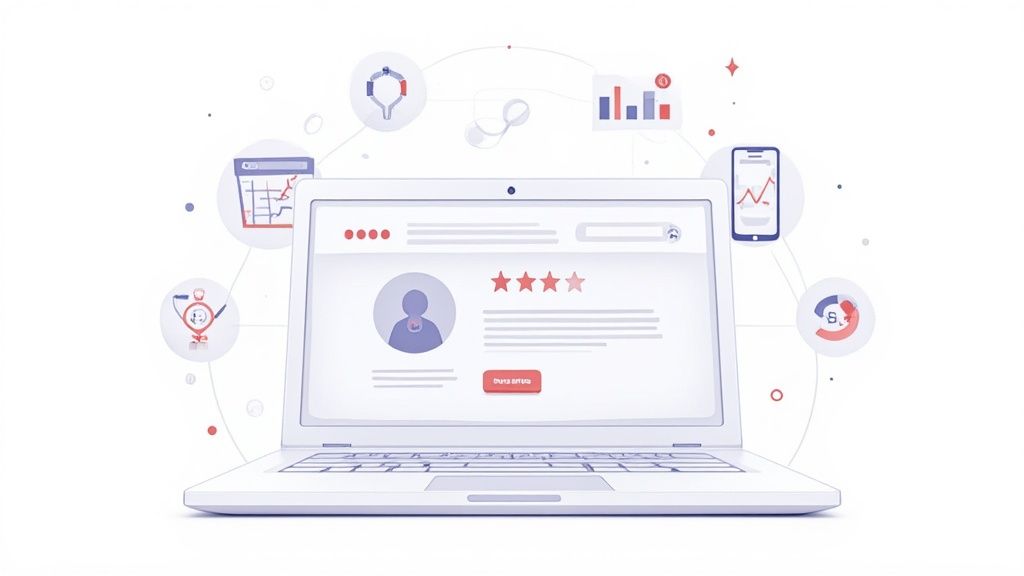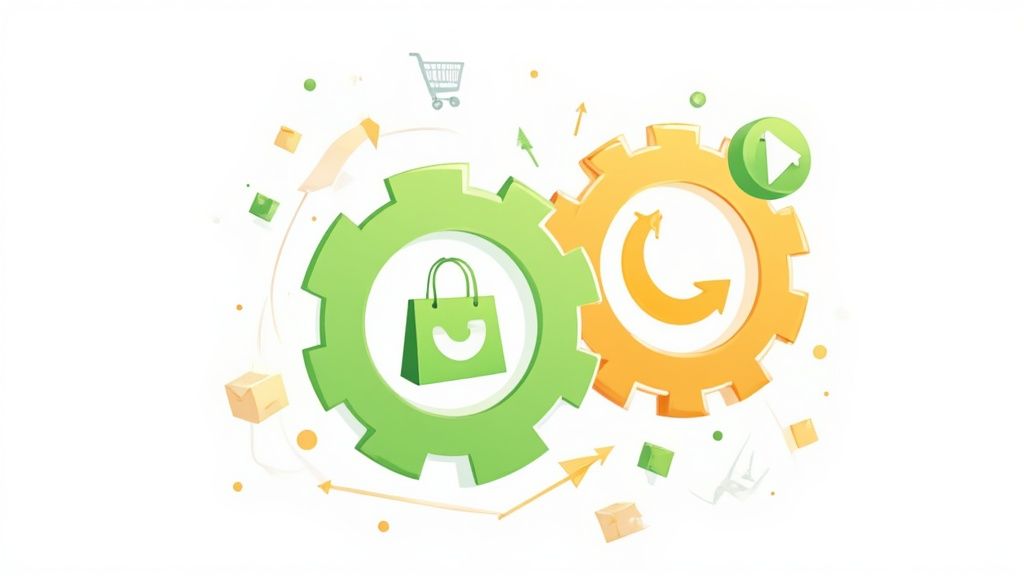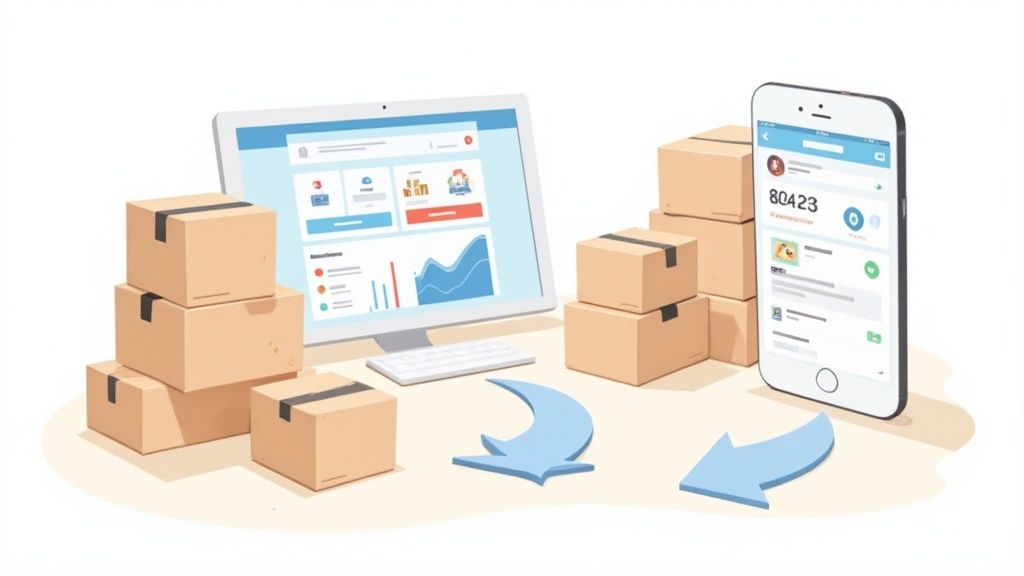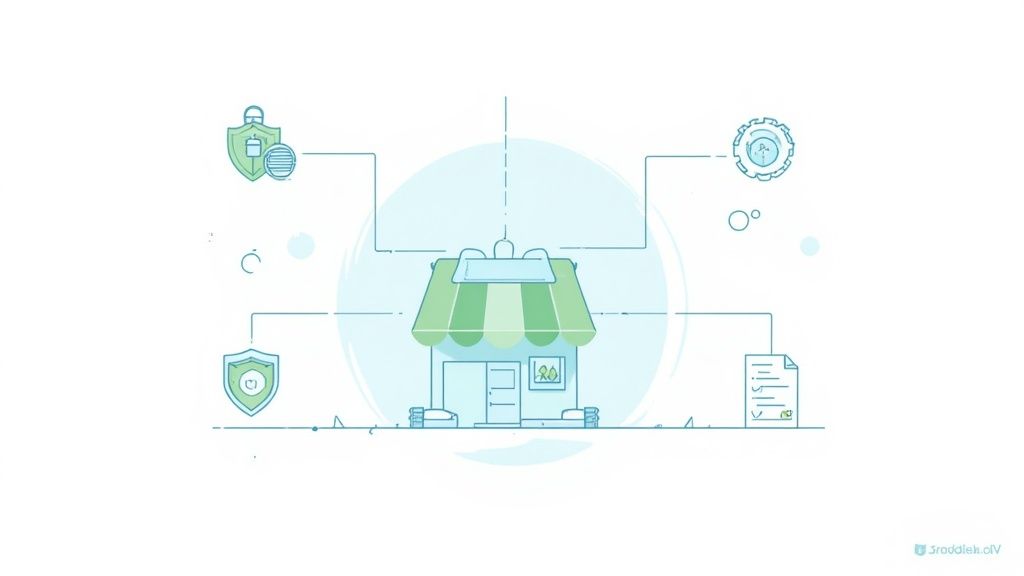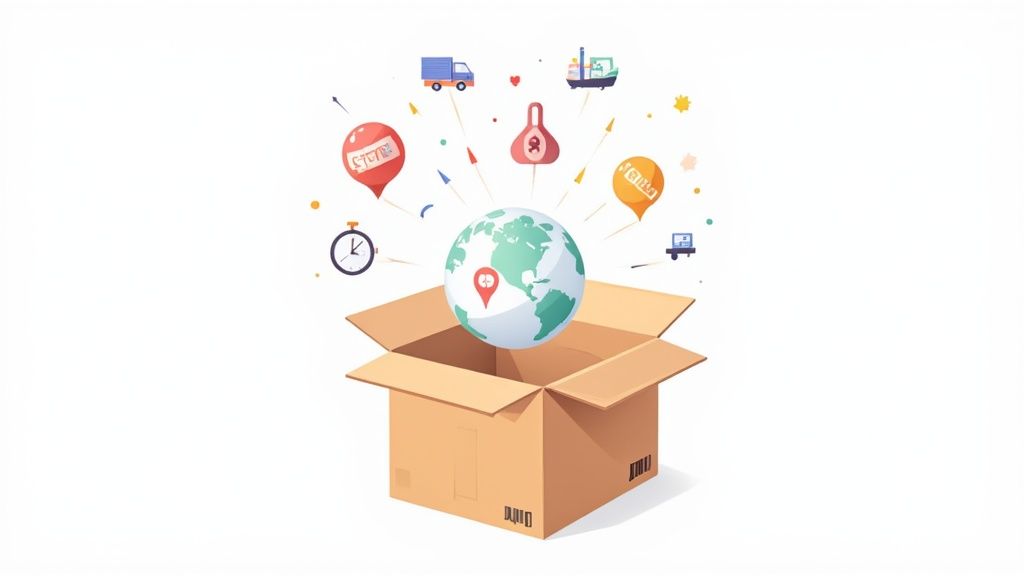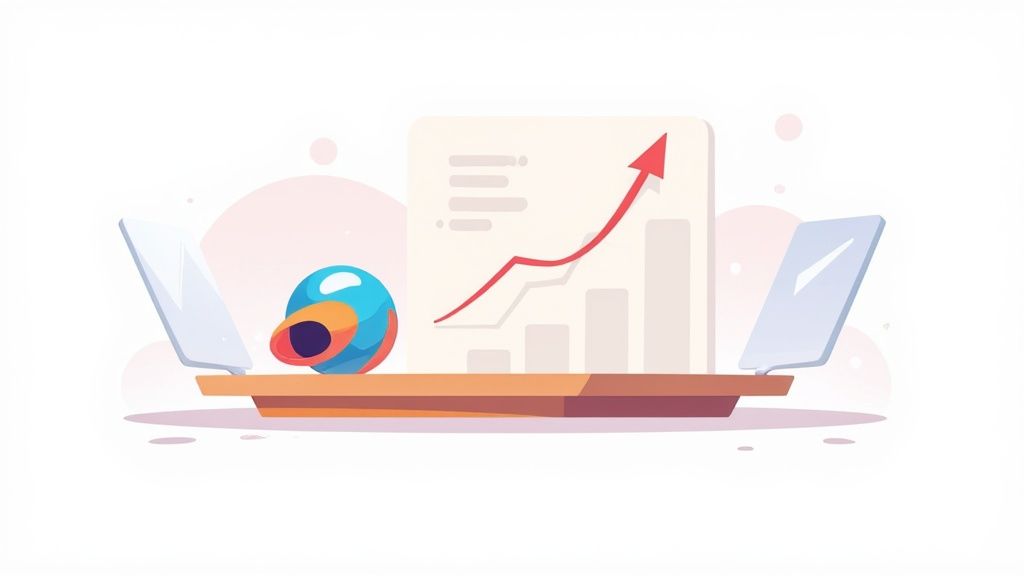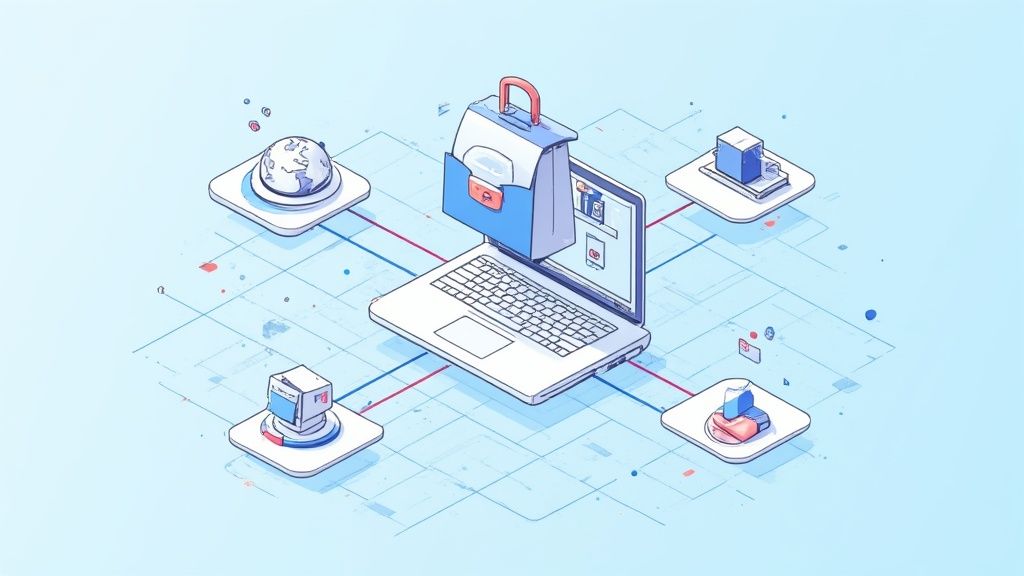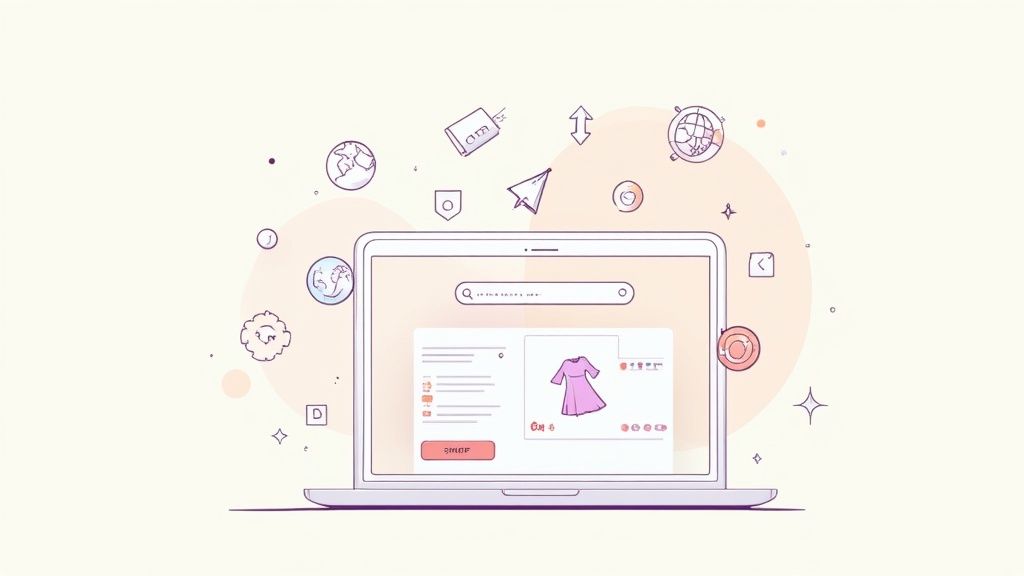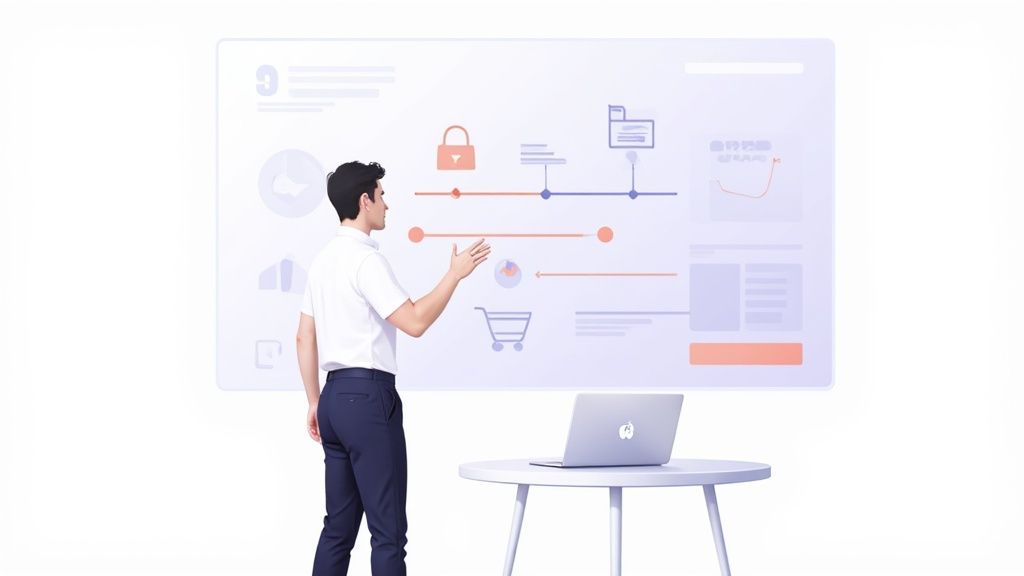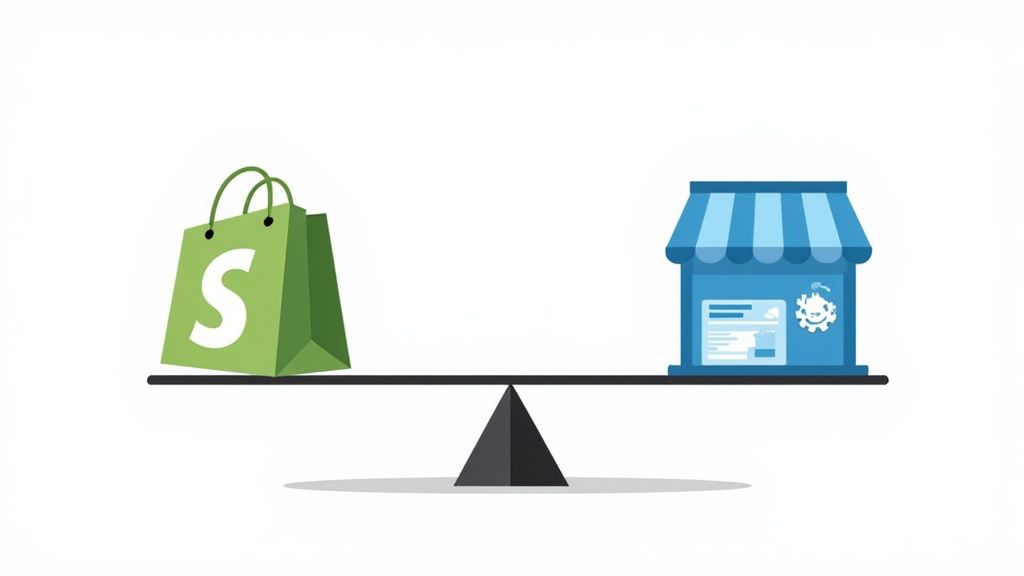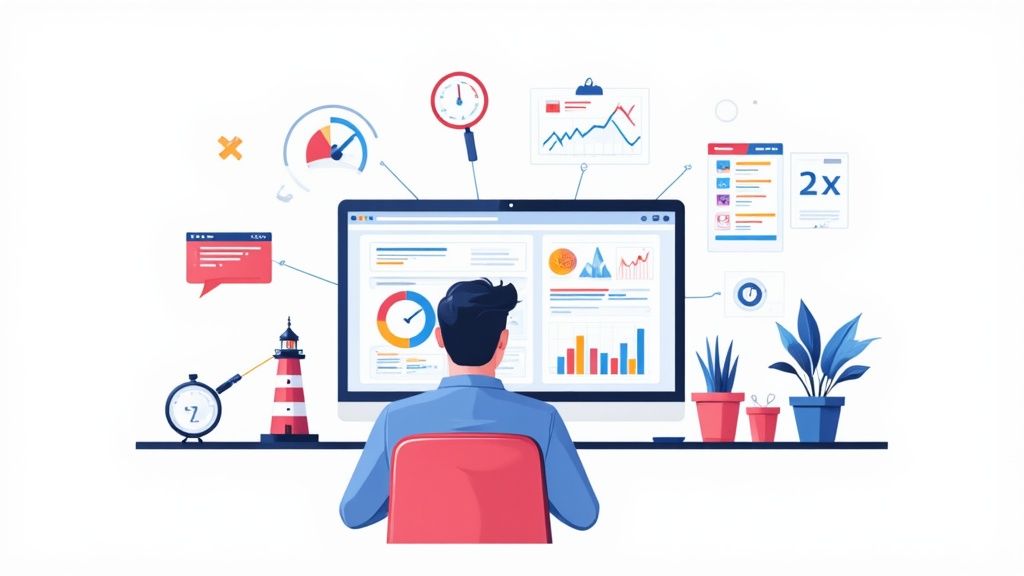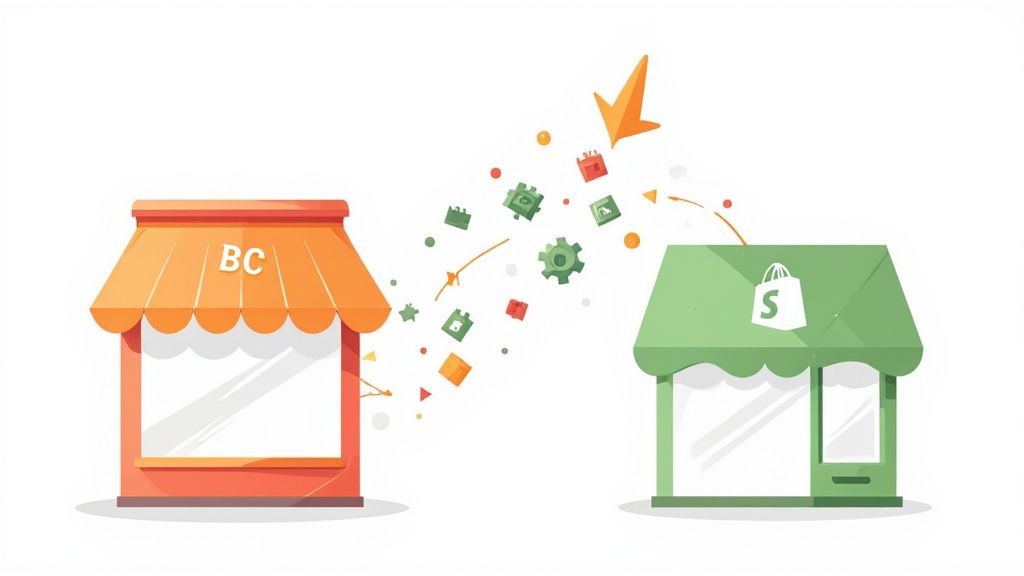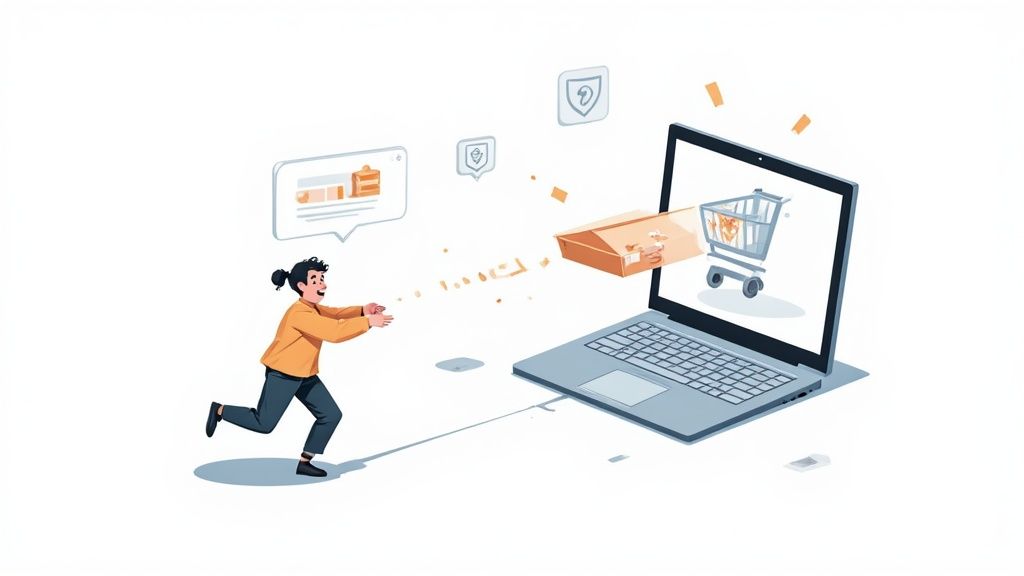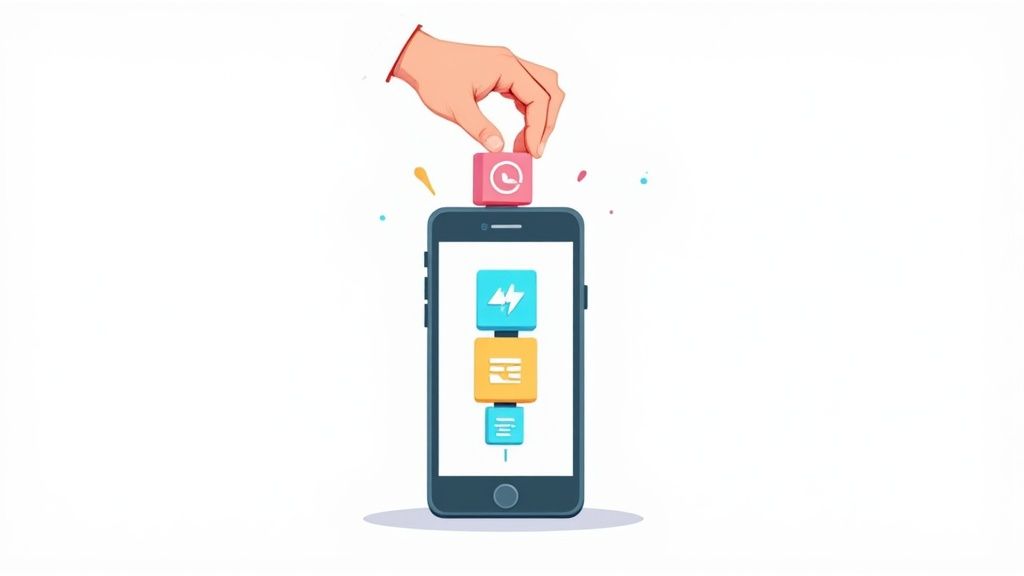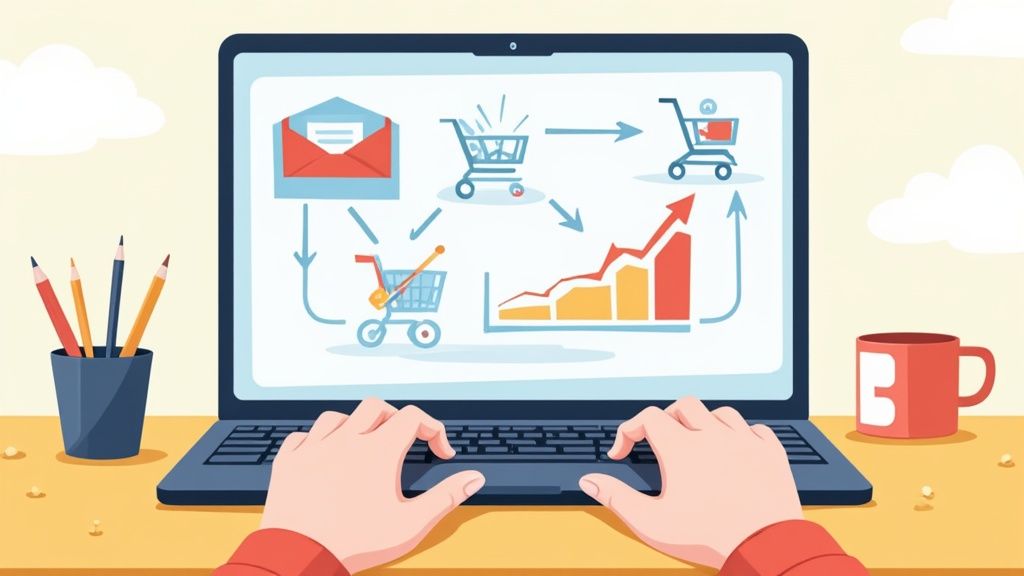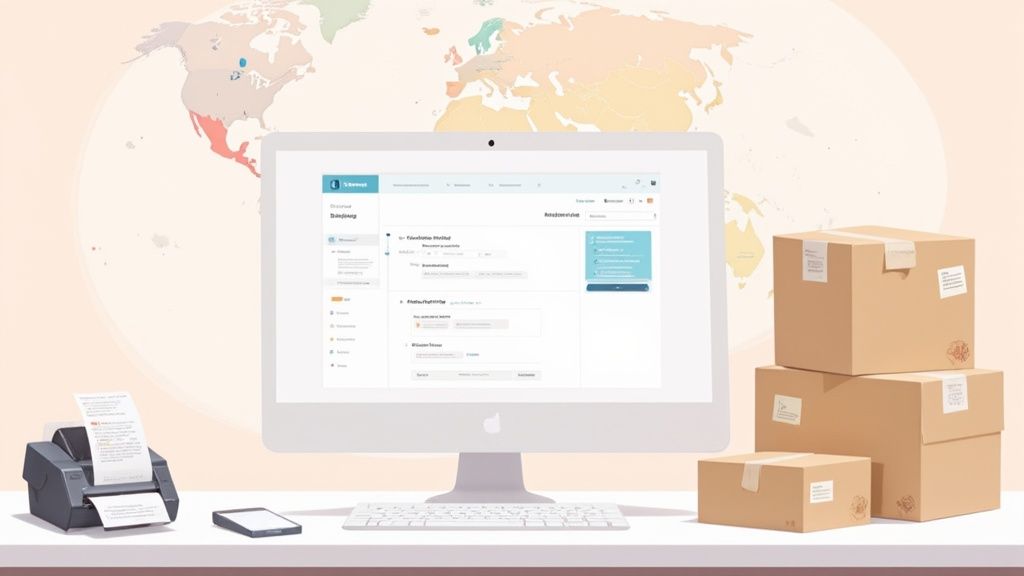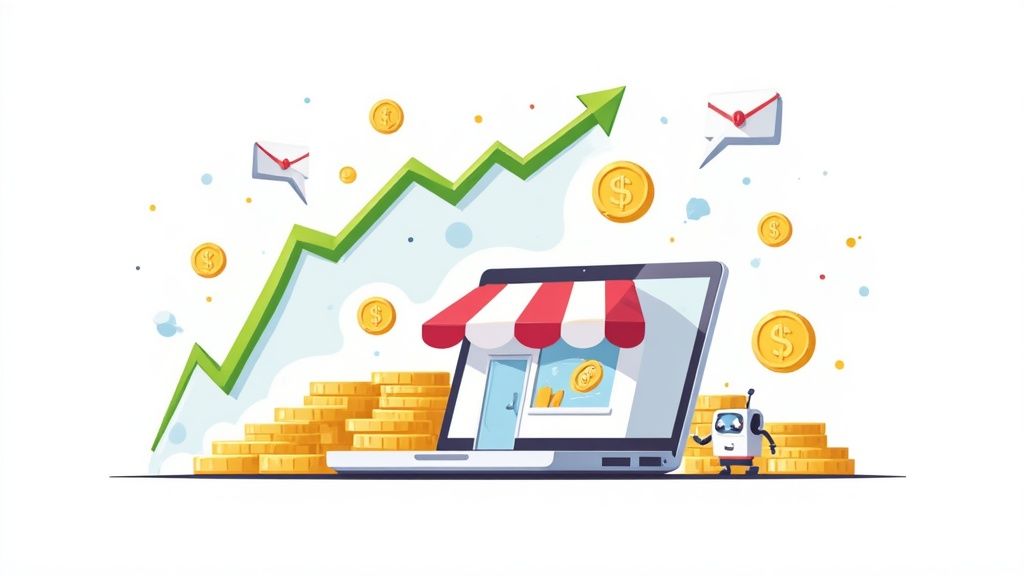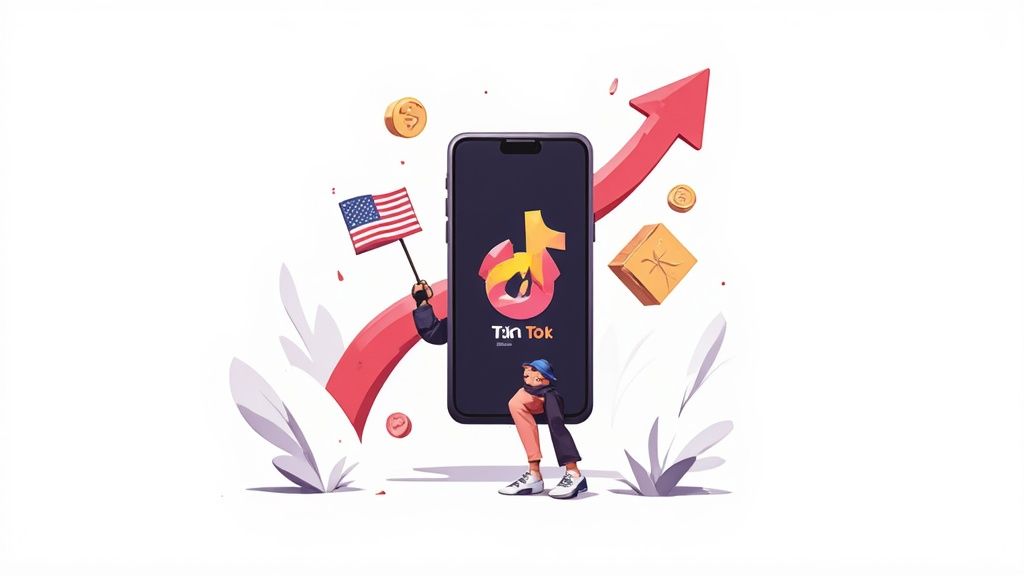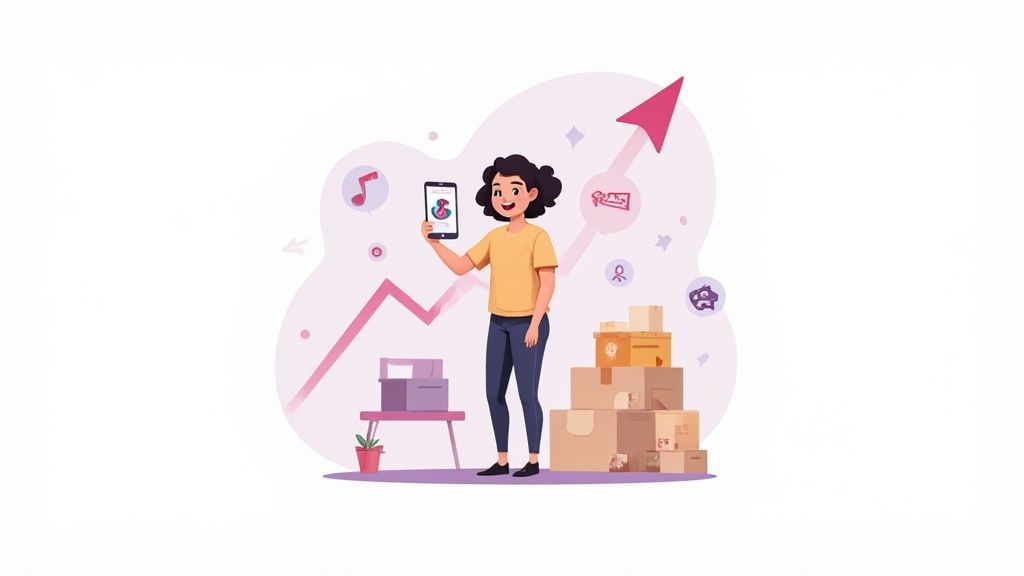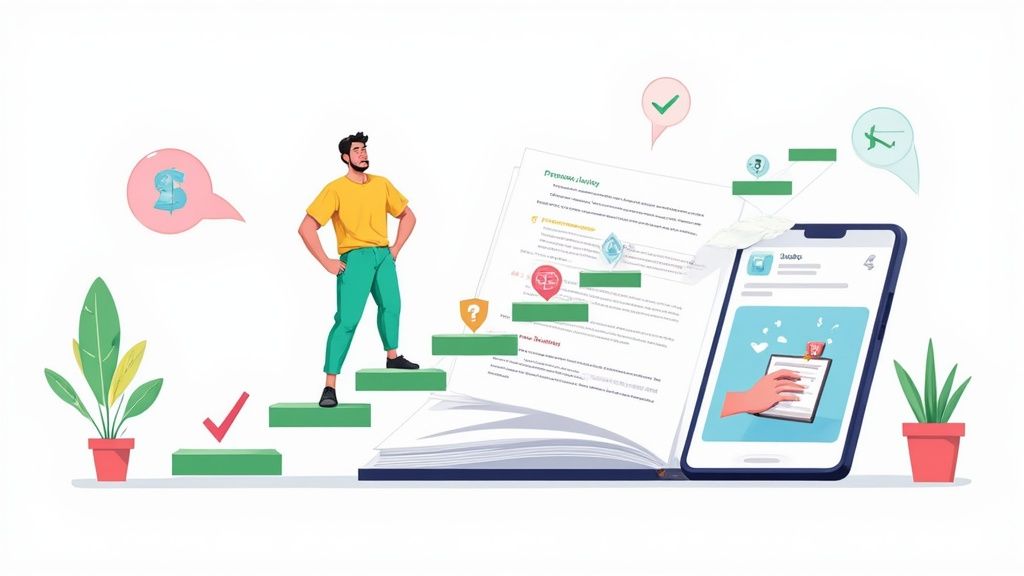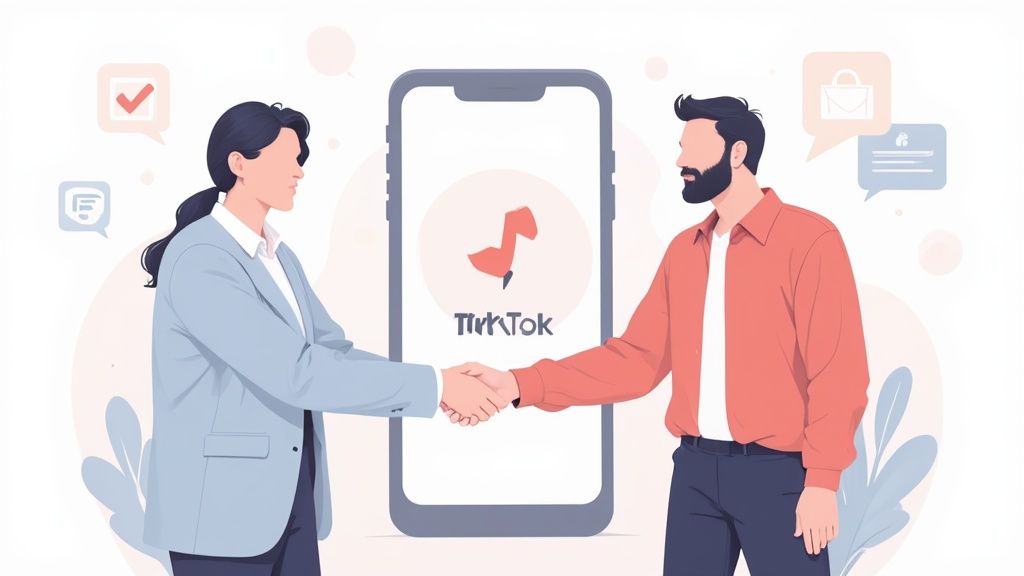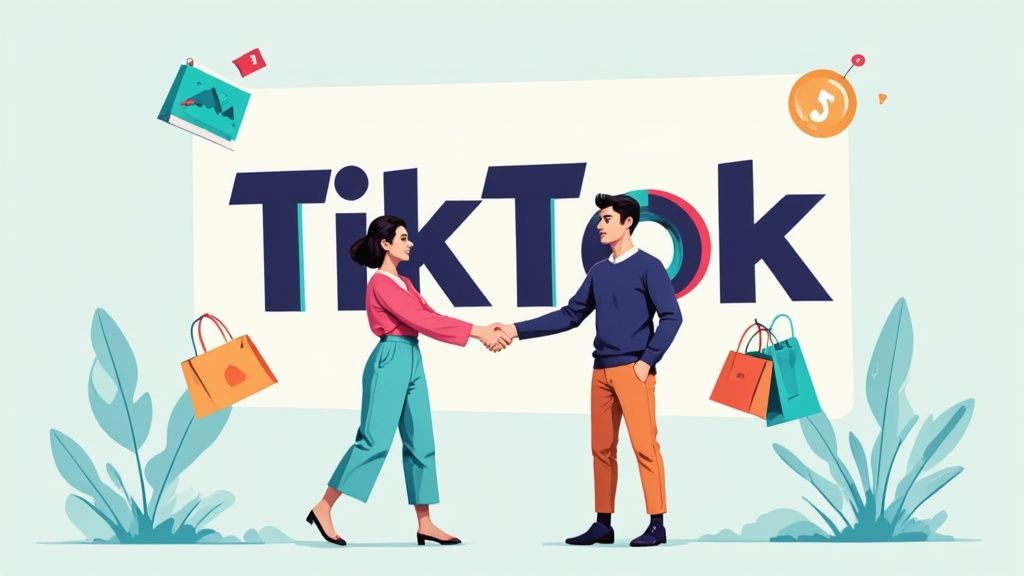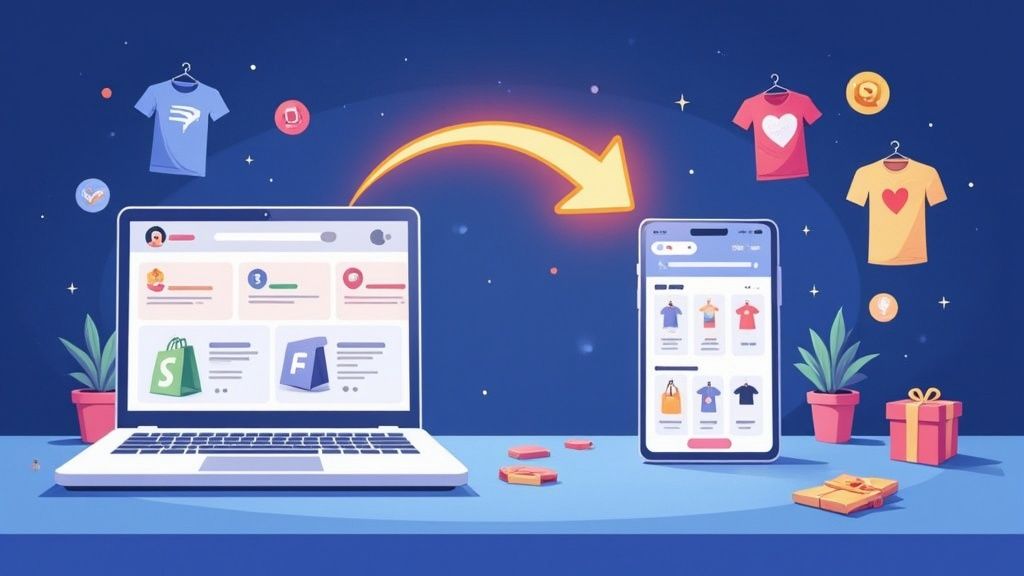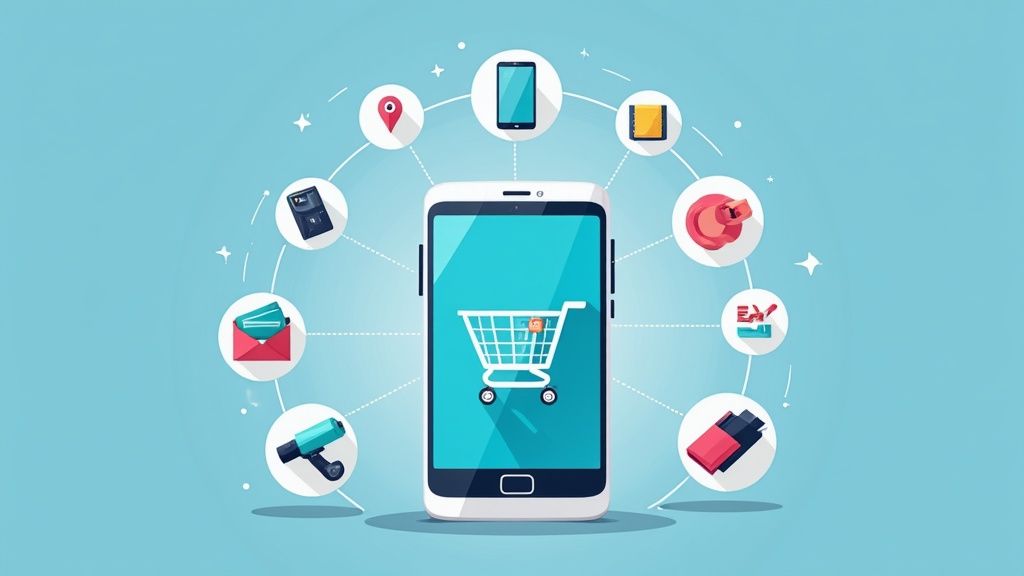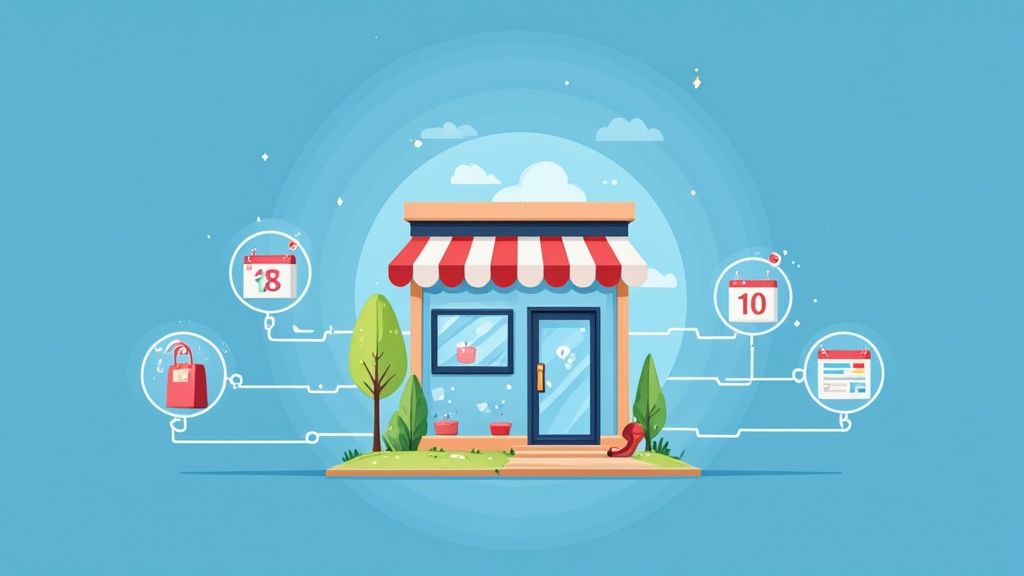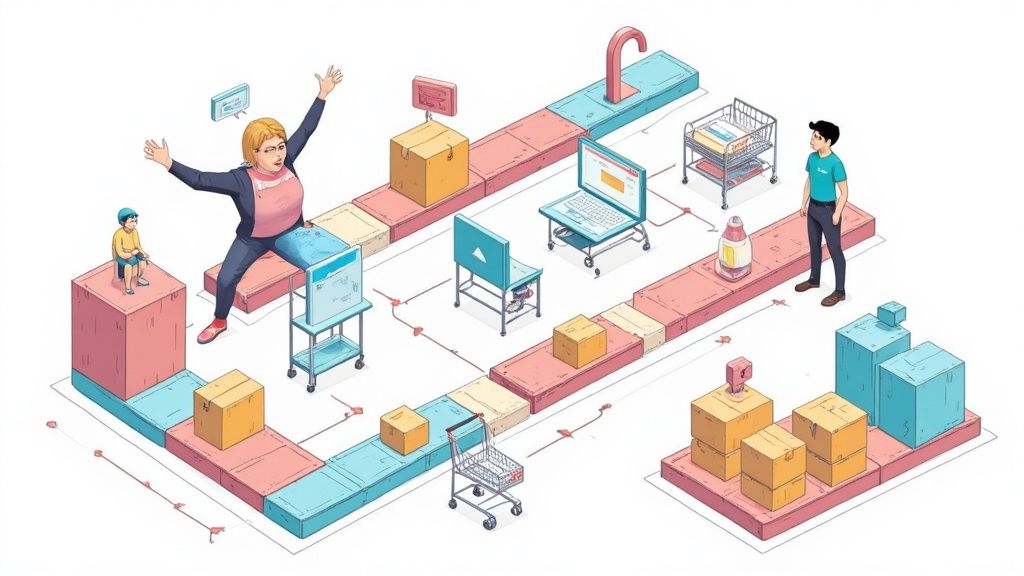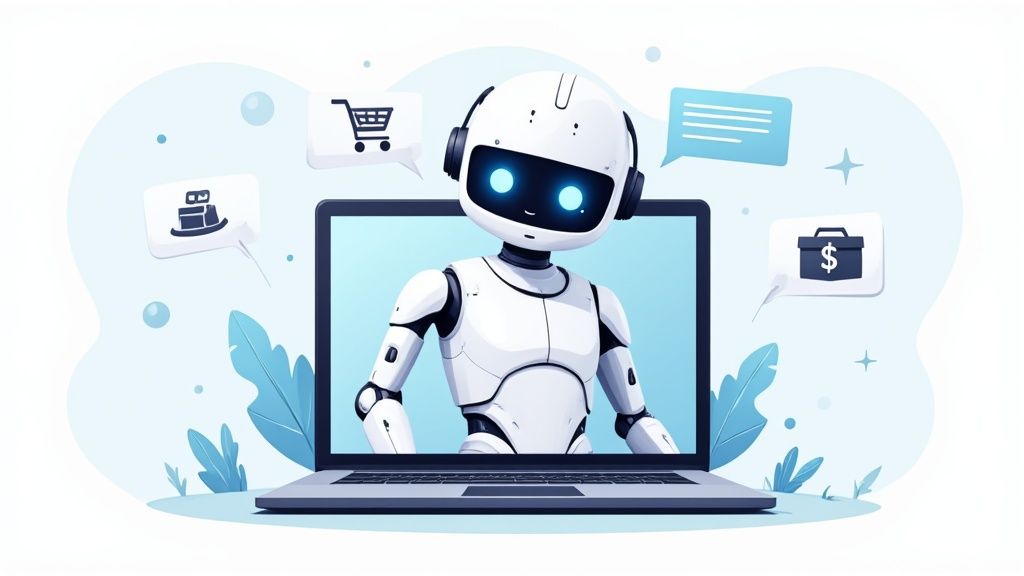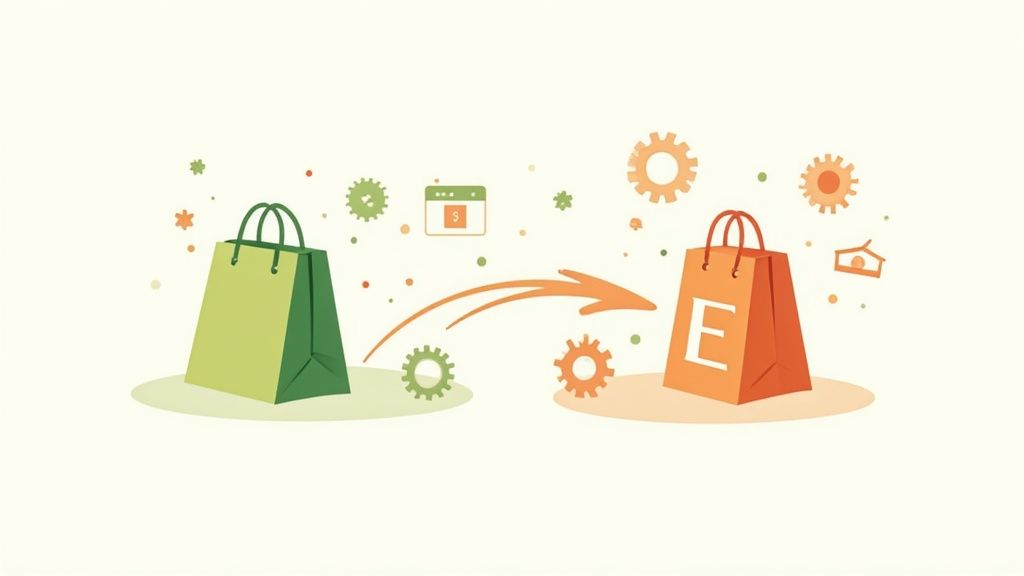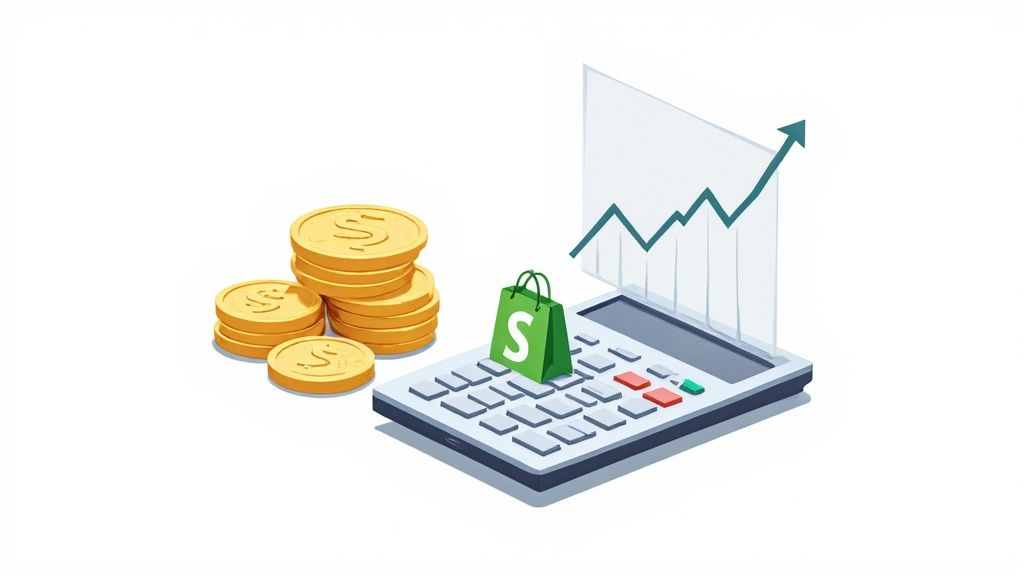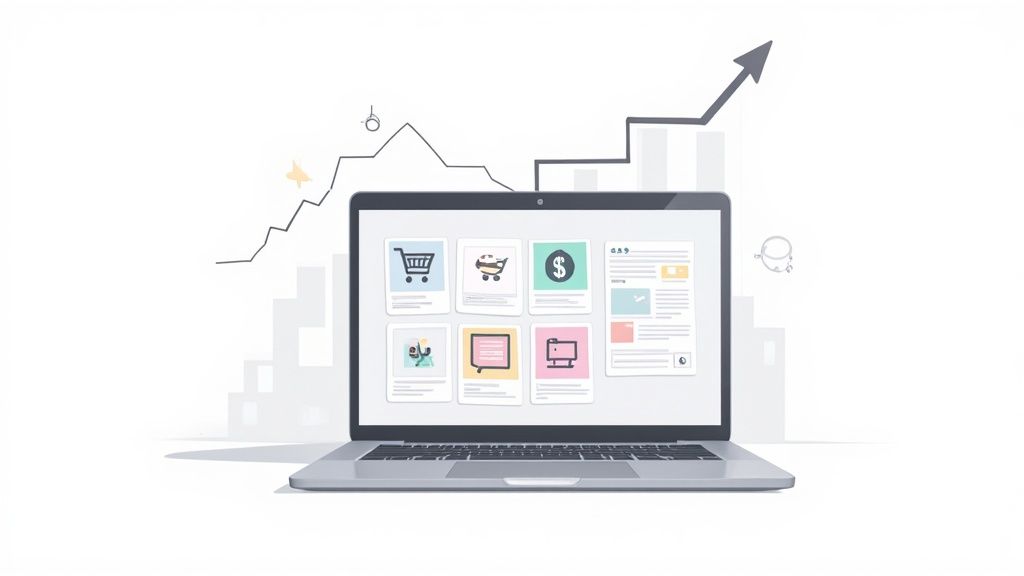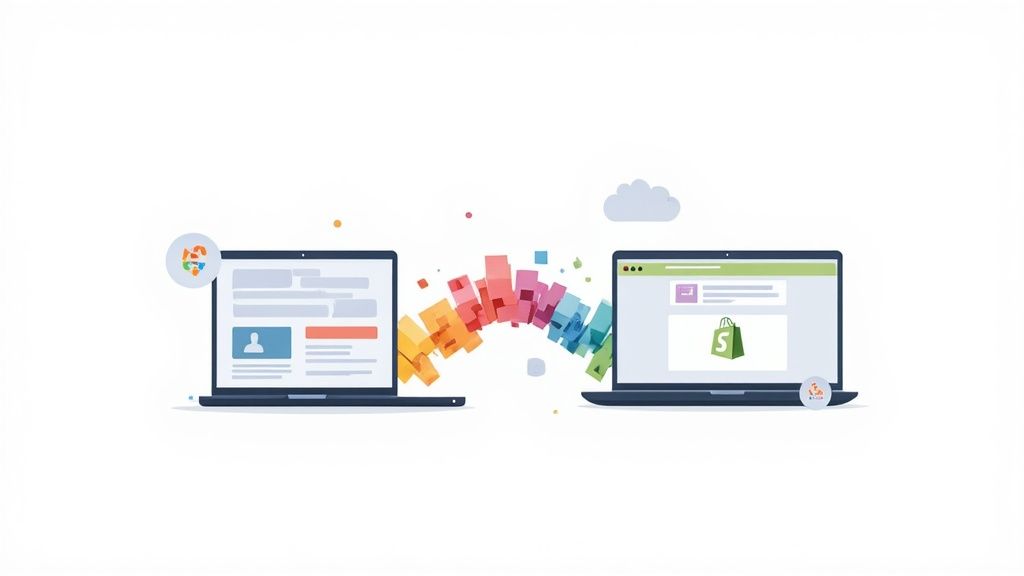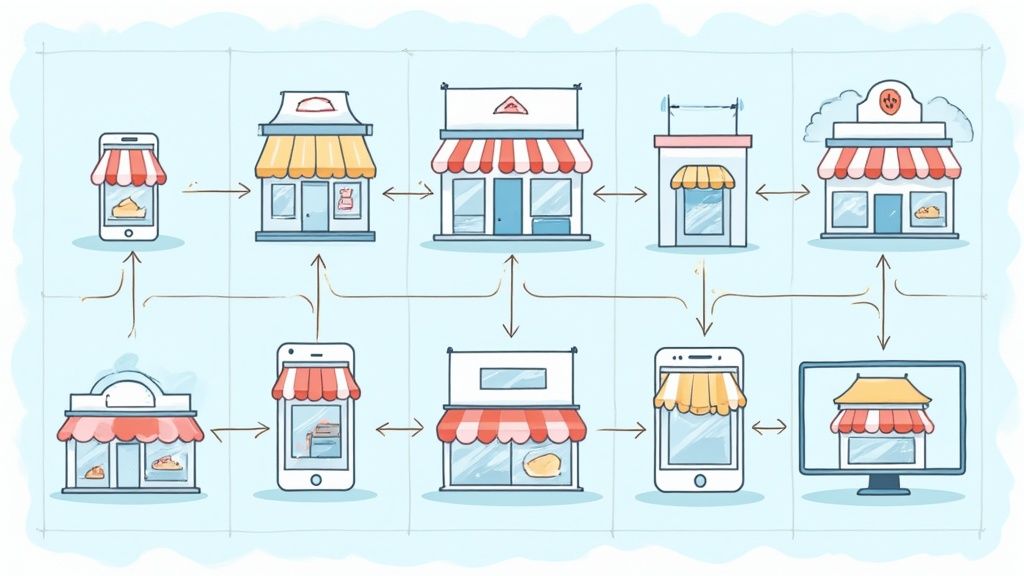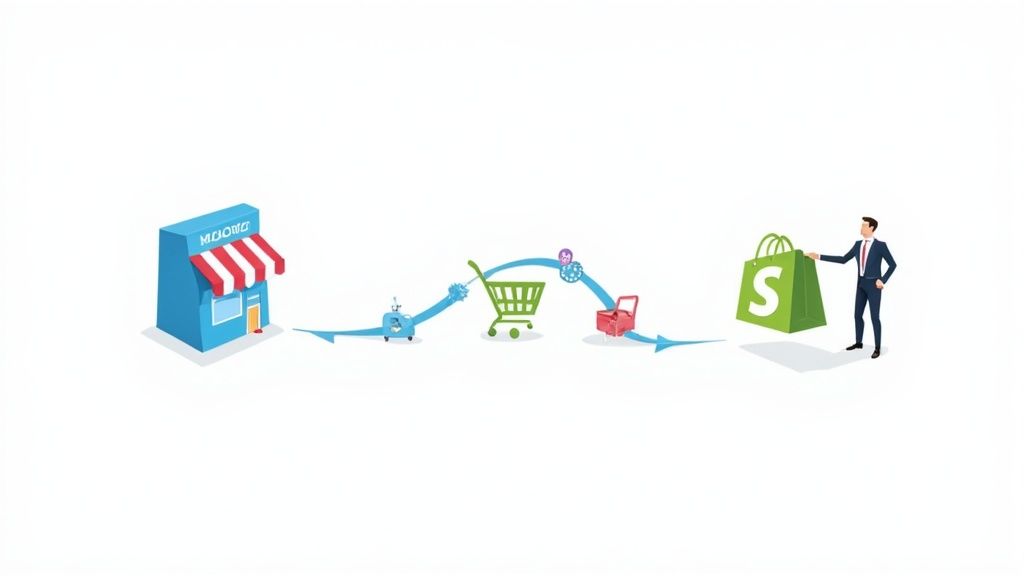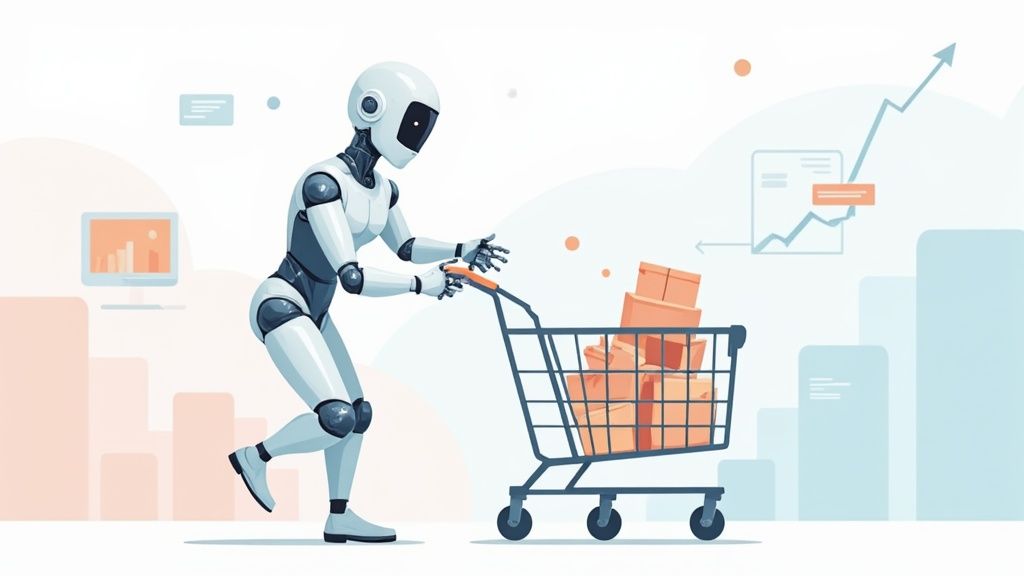
Picture an online store that feels less like a website and more like a personal shopper—one that knows what you want almost before you do. This isn't science fiction; it's the new reality that artificial intelligence is building for online retail. The most powerful ai applications in ecommerce are all about hyper-personalization, operational efficiency, and enhanced product discovery.
The New Era of Smart Shopping
Forget the old days of generic storefronts and one-size-fits-all marketing. AI is completely overhauling the way online commerce works, turning standard digital shops into intelligent partners for both customers and businesses. This is less about futuristic robots and more about using data to make smarter, faster, and more personal decisions at every single touchpoint.
Instead of just passively collecting customer data, AI actively learns from it. Every click, search, and purchase is a clue that teaches the store how to interact with that specific person. This guide will cut through the noise and show you exactly how real businesses are using AI to build these smarter shopping experiences.
Core Pillars of AI in Ecommerce
You can really boil down AI's impact into three main areas, and they all work together to create a more efficient and profitable business.
- Intelligent Personalization: This is all about crafting a unique journey for every single customer. AI looks at user behavior to serve up tailored product recommendations, personalized marketing, and dynamic content that makes each visitor feel like the store truly gets them.
- Operational Automation: Behind the scenes, AI is an absolute workhorse for automating complex tasks. It can predict future demand to keep inventory just right, adjust prices on the fly for maximum profit, and even spot fraudulent transactions before they can cause any trouble.
- Enhanced Discovery and Support: AI is also brilliant at helping customers find what they need, and find it fast. Think visual search tools that can identify a product from a photo or smart chatbots that are ready to help 24/7.
The infographic below really brings to life how these key AI applications—personalization, operations, and discovery—are the cornerstones of a modern retail strategy.
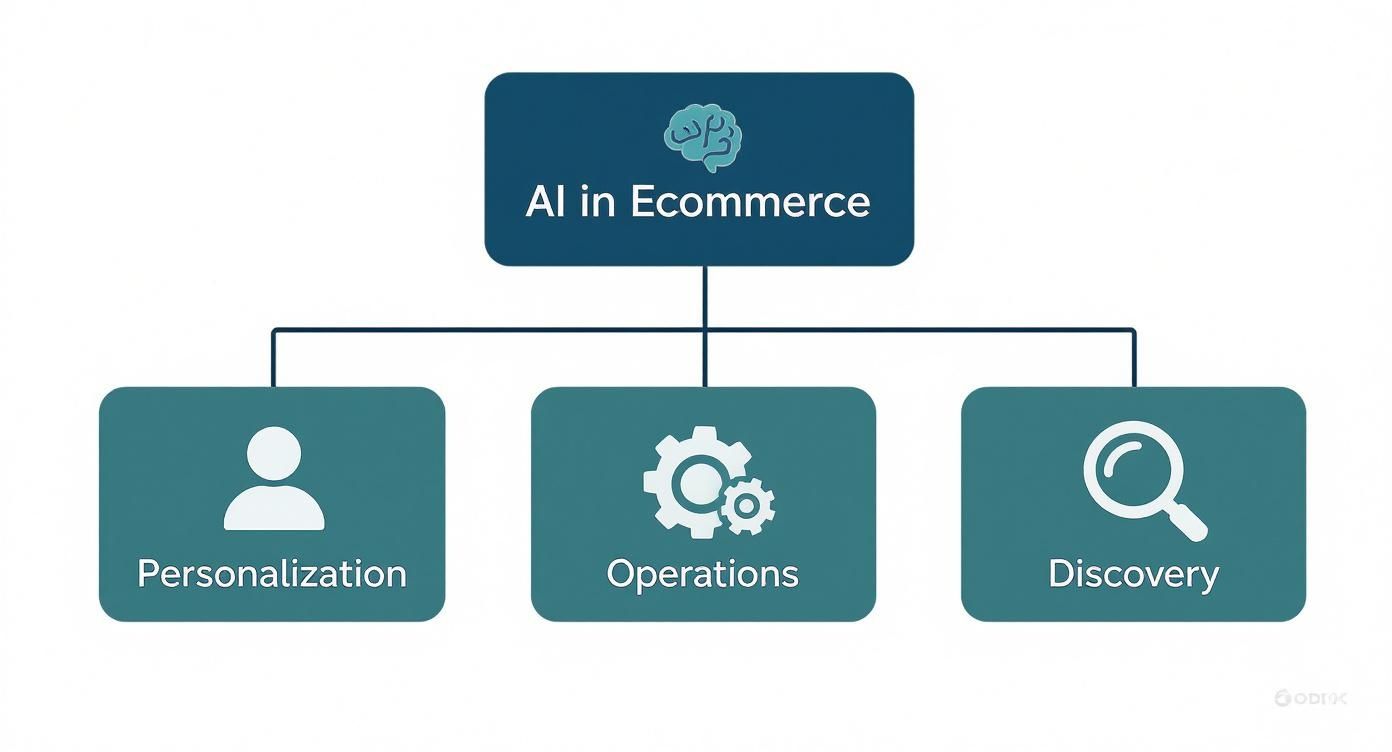
As you can see, it's not about choosing one area over the other. All three pillars support each other to build a smarter, more responsive e-commerce ecosystem that drives both customer happiness and serious business growth.
Personalizing The Customer Journey With AI

This is where AI in e-commerce really starts to shine. It's about turning anonymous visitors into a community of understood, valued customers. The goal is to make every single shopper feel like your store was built just for them.
Think about how your favorite streaming service works. It doesn’t just show you what’s popular—it learns your tastes so well that it can suggest your next favorite show before you even know what you're in the mood for. That's exactly what AI-powered personalization does for retail, but it goes far beyond a basic "customers who bought this also bought..." widget.
These sophisticated systems are like digital detectives, analyzing every clue a shopper leaves behind. They look at browsing behavior, purchase history, what’s been added to the cart, and even how a person moves their mouse in real time. All this data builds a unique profile for each visitor, allowing your store to show them products that genuinely match their style and what they're looking for right now.
Driving Engagement With Smart Recommendations
The whole point of AI personalization is to make shopping feel completely natural and intuitive. When you show customers exactly what they’re most likely to want, you remove the friction and make the path to checkout incredibly smooth.
The result is almost always a major lift in key metrics. When your store accurately predicts what a customer needs, it builds trust and satisfaction, encouraging them to buy more and come back more often. To get the most out of this, it's also smart to brush up on other proven tips to improve website conversion rates.
By presenting the right product at the right time, AI personalization can increase average order value (AOV) by suggesting complementary items or relevant upsells. This turns a single-item purchase into a full cart.
The financial upside is clear. The global AI-enabled e-commerce market was valued at $8.65 billion in 2025 and is projected to skyrocket to $22.60 billion by 2032. This isn't just a trend; it's a massive industry-wide investment in making shopping smarter.
Beyond Products: Tailored Marketing Automation
Personalization isn’t just about the products you show on your site. AI also brings a new level of sophistication to your marketing, making sure every email, ad, and notification actually resonates with the person receiving it.
Instead of blasting generic emails to your entire list, AI helps you segment your audience into tiny, hyper-specific groups based on their actions and preferences. This makes it possible to run campaigns that feel less like marketing and more like helpful advice.
- Behavioral Triggers: An AI system can automatically send an email featuring a specific category of products right after a user has spent time browsing them.
- Predictive Offers: Based on past purchases, the AI might predict when a customer is running low on a consumable product and send a timely reminder with a discount.
- Dynamic Ad Content: The ads a customer sees on social media can be dynamically populated with products they recently viewed or items that complement a recent purchase.
This level of detail makes shoppers feel understood, not just targeted. By delivering real value at every touchpoint, you build stronger relationships and create the kind of loyalty that lasts. If you want to see how the pros are doing it, check out these real-world AI personalization ecommerce examples for a look at how leading brands are finding success.
Optimizing Your Operations with AI
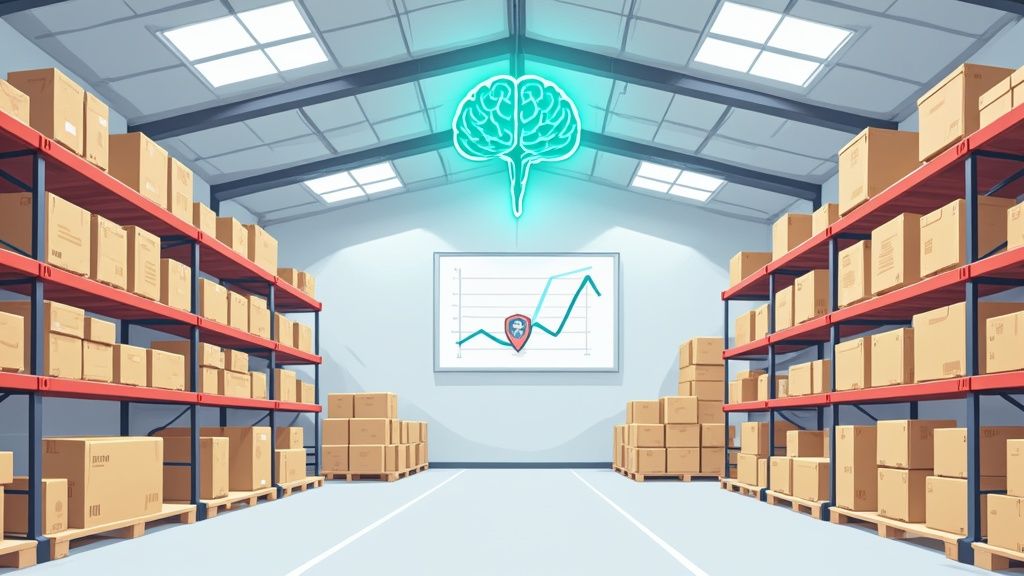
Sure, personalized shopping gets all the attention, but some of the most powerful AI applications in ecommerce are humming along quietly behind the scenes. These tools are all about overhauling the core of your business, creating efficiencies that fatten your bottom line and keep customers happy. Think of it as upgrading your store’s engine, not just giving it a new paint job.
What AI brings to the table is a shift from putting out fires to proactively planning ahead. You stop guessing what might sell next month and start predicting it. You stop manually tweaking prices and start automating the process based on real-time data. This is the operational intelligence that separates the brands that are scaling from those just trying to keep up.
Predictive Inventory Management
Let's be honest: managing stock is one of the biggest headaches in retail. Too much inventory ties up your cash and risks becoming dead weight. Too little, and you're dealing with frustrated customers and watching sales walk out the door. AI-powered inventory systems are like having an expert financial forecaster dedicated to your products.
These systems dig into everything—historical sales data, current market trends, seasonality, even external factors like an upcoming holiday or a product suddenly going viral on TikTok. By seeing patterns humans would miss, the AI can forecast future demand with scary-good accuracy. It lets you dial in your stock levels perfectly, so you have exactly what customers want, right when they want it.
And this isn't just about avoiding empty shelves. Six out of ten retail buyers say AI has already improved their demand forecasting, helping them dodge millions in lost revenue from both overstocking and stockouts.
The end result? A much more nimble and resilient supply chain. Your business can automatically trigger reorder points, get suggestions for transferring stock between warehouses, and cut down on waste. All of this frees up capital that would otherwise be just sitting on a shelf.
Dynamic Pricing and Revenue Optimization
Finding the sweet spot for a product's price is a delicate dance. Go too high, and you lose out to competitors. Go too low, and you're leaving money on the table. AI-powered dynamic pricing strips the guesswork from this critical decision.
Picture an algorithm that acts like your own personal market analyst, working 24/7. It crunches a constant stream of real-time data points:
- Competitor Pricing: The system keeps an eye on what your rivals are charging and can adjust your prices to stay in the game.
- Customer Demand: When an item starts getting a lot of buzz, the price can be nudged up to maximize revenue while it's hot.
- Inventory Levels: If you're sitting on too much of a particular product, the AI can roll out smart markdowns to clear it out without tanking your margins.
This automated approach means your store can react to market shifts in minutes, not days. The system can even personalize offers at the point of sale, maybe giving a small discount to a hesitant buyer while keeping the full price for a loyal customer. It’s about optimizing profit on every single transaction, ensuring you're always priced for maximum profitability and relevance.
Making Shopping Easier with Smarter Discovery and Support
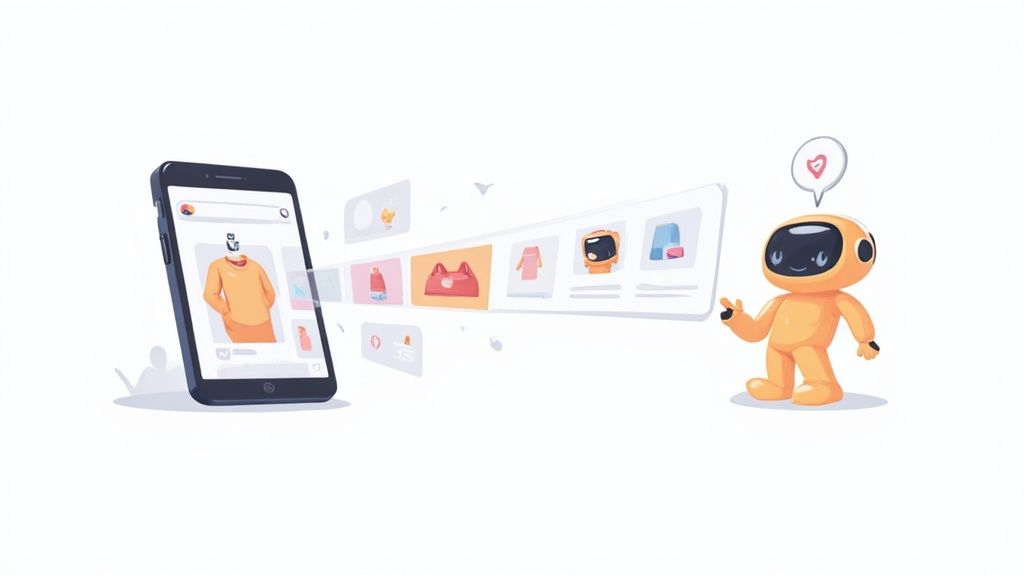
How do you help a customer find the perfect item when they can't quite find the right words to describe it? It's a classic e-commerce headache, but it’s one where AI steps in to turn a potentially frustrating search into a "wow" moment. Instead of just matching keywords, AI gives your store the power to think more like a helpful human assistant.
One of the coolest applications here is visual search. Imagine a shopper sees a chair they love on Instagram. Instead of trying to guess the right keywords ("modern grey armchair with wooden legs"?), they can just upload a picture to your store. AI gets to work, instantly analyzing the image for color, shape, and style to pull up your closest matches.
This kind of technology is a total game-changer for industries like fashion, home decor, and beauty—anywhere visuals are king. It closes the gap between seeing something you want and being able to buy it, making your entire catalog accessible to shoppers who know what they want when they see it.
Upgrading Your Search Bar
Beyond just pictures, AI is also making the traditional text search bar way smarter with Natural Language Processing (NLP). This is the same tech that lets Siri and Alexa understand how you actually talk. For an e-commerce site, it means your search bar can finally understand intent, not just words.
For example, a customer might type in "warm winter coats for hiking" instead of just "winter coats." An old-school search might get confused or show everything. An NLP-powered search understands the context—it knows to prioritize products that are insulated, waterproof, and tagged for outdoor use. This kind of intuitive experience keeps people on your site and drastically cuts down on frustrated bounces.
Offering Instant, 24/7 Help
Once a customer finds something they like, the questions start. "When will it ship?" "What's the return policy?" "Is this machine washable?" This is where AI-driven support takes over, turning customer service from a necessary cost into a powerful tool for keeping customers happy.
Modern AI chatbots aren't the clunky, annoying bots we all used to hate. Today’s versions are sophisticated assistants that can handle a massive range of common questions, at any time of day.
- Order Tracking: Bots can give real-time updates on a package’s location instantly.
- Product Questions: They can answer FAQs about materials, sizing, or how to use a product.
- Return Processing: AI can walk customers through starting a return or exchange without them ever needing to wait for an agent.
By automating all these routine tasks, AI chatbots free up your human support team to tackle the complex, high-stakes issues that really need a personal touch. It’s no surprise that during peak seasons, retailers using AI chatbots have seen a 15% boost in conversion rates just by providing instant answers and removing friction at checkout.
These intelligent helpers create a smooth, seamless support experience that builds trust and keeps customers coming back. To get a better handle on this, you can learn more about how to best implement AI chatbots for ecommerce and see how they can completely reshape your customer service.
How to Implement AI in Your Business
Jumping into AI might feel like a massive, complicated project, but it’s more approachable than you’d think. This isn’t about immediately hiring a team of data scientists; it’s about making smart, strategic moves, one step at a time. And the very first step? Getting your data in order.
AI runs on data. Simple as that. A chef can’t make a gourmet meal with bad ingredients, and an AI can't deliver good results with messy, incomplete information. You need clean, organized, and sufficient data to give it something to work with.
As a rule of thumb, you should have at least 12 to 18 months of historical data ready to go. This includes everything from orders and customer behavior to your product catalog. Before you even look at a single tool, your priority is making sure this data is accurate and you can actually get to it.
Choosing Your Starting Point
Once your data is clean and ready, you’ve got to decide how you’ll get started. There are two main paths: using ready-made solutions or building something from scratch. For most e-commerce businesses, the smart money is on starting with off-the-shelf tools.
Platforms like Shopify and other big players already have AI features baked right in. Often, you can turn them on with just a few clicks. They're built to solve common problems and give you a quick win.
- Start with a Single Goal: Don’t try to boil the ocean. Pick one area where you know you can make a big impact. Maybe that's using AI to auto-generate product descriptions, or it could be as simple as adding a smart chatbot to field common customer service questions.
- Focus on Clear ROI: Choose a project where you can easily see the return. Firing up an AI-powered product recommendation engine, for instance, should lead directly to a measurable lift in average order value.
The name of the game is starting small and proving the concept works. A single successful pilot project creates the momentum you need to get everyone on board for more ambitious AI projects later on.
Finding the Right AI Solution
The market for e-commerce AI is absolutely exploding. Projections are all over the place, but some analyses saw the global market hitting $16 billion by 2025. This isn't just hype; it reflects real, widespread use for everything from fraud detection to customer support. If you want to dive deeper into the numbers, you can find a ton of great reports on digital commerce statistics and industry growth.
This boom is great news for you, because it means there’s almost certainly a tool out there that fits your business perfectly. When you’re looking at your options, just ask a few simple questions:
- Will this plug into our existing tech without a huge headache?
- Can my non-technical team members actually use it?
- Does the company offer good support if we get stuck?
Start with good data, pick a focused project, and choose the right ready-made tool. That’s the formula. This approach cuts down the risk and gives you the best shot at seeing a real, tangible impact on your bottom line.
Common Questions About AI in Ecommerce
Dipping your toes into the world of AI can feel like learning a new language. New terms, new tools, new tech—it's a lot to keep up with. It's only natural for business owners to have some practical questions about what it really takes to get started and what they can actually expect.
This section is all about giving you clear, straightforward answers to the most common questions we hear. My goal is to pull back the curtain and show you just how accessible and powerful these tools can be, even for smaller shops. Let's tackle some of those big uncertainties.
What Is the Most Impactful AI Application for a Small Ecommerce Business?
For a small business, the best place to start is with tools that give you a quick win—something that directly boosts sales or makes customers happier, fast. The best ai applications in ecommerce for a lean team are the ones that deliver a big punch without needing a huge budget or a data science degree to run.
Think of it as finding a force multiplier. You want tools that amplify the work you're already doing.
- AI-Powered Product Recommendations: This is a fantastic starting point. A smart recommendation engine can instantly lift your average order value by showing customers other items they might love but would have otherwise missed. It’s like having a helpful sales associate on every single product page.
- AI Customer Support Chatbots: A good chatbot can be a game-changer. It can handle all the common questions that pop up 24/7, from "Where's my order?" to "What's your return policy?" This keeps customers happy and frees up your time to focus on the bigger picture—you know, growing the business.
The best part? Many modern ecommerce platforms have these features built right in or available as simple app integrations. Getting started is easier than ever.
Do I Need Technical Knowledge to Use AI?
Not anymore. A few years ago, the answer might have been different, but today, things have changed dramatically. While building a custom AI model from scratch is definitely a job for an expert, that's not something most businesses will ever need to do. The market is now full of "plug-and-play" AI solutions built for people like you and me.
The rise of user-friendly AI is democratizing powerful technology. It's opening the door for anyone, regardless of their technical background, to bring their business ideas to life and compete on a much more level playing field.
Platforms you already use—from your ecommerce host to your email marketing software—have integrated user-friendly AI features. You can often switch them on with just a few clicks to start personalizing marketing, forecasting inventory, or optimizing prices, all without writing a single line of code. The real skill is knowing what you want to achieve and then picking the right tool for the job.
How Does AI Help Reduce Cart Abandonment?
Ah, the dreaded abandoned cart. It’s a thorn in the side of every online store owner, but AI gives you a few different ways to fight back and recover those would-be sales. It’s all about intelligently stepping in at the exact moment a customer is thinking about leaving.
First, exit-intent technology is pretty clever. It can actually detect when a shopper's mouse is heading for the "close tab" button. This triggers a perfectly timed pop-up with a special offer, a discount code, or a simple reminder, giving them a compelling reason to stick around and finish their purchase.
Second, AI can supercharge your cart recovery emails. Instead of sending a generic "You left something behind!" message, it can create hyper-personalized emails. These can show the exact items in their cart, suggest similar products, or even include a unique, time-sensitive discount to create a little urgency.
Finally, AI chatbots can be your proactive checkout buddy. If a shopper is hesitating on the checkout page, a chatbot can pop up and offer to answer any last-minute questions about shipping, returns, or payment options. Often, clearing up that one final doubt is all it takes to get them to click "buy."
Ready to see how AI can transform your own Shopify store? The team at ECORN specializes in implementing smart, scalable solutions that drive real growth. Let's build a smarter ecommerce experience together.








